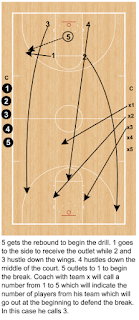Quality Possessions
There are many different metrics which are used by coaches to gage why a result of a game may have turned out the way it did. Some like to use turnovers, others like to use rebounding differential, others like to use field goal percentage, and the list goes on and on. The one metric that I like to use takes many of the stats other coaches use and combines them into one figure and it is called Quality Possessions Percentage (QP%).
The formula for this stat is simple:
Quality Possessions/Total possessions (quality possessions + poor possessions)
This percentage should be above 60%.
At this point one might ask what constitutes a quality possession. The list below helps:
All baskets made
Any layup attempt regardless of make or miss
Any possession that shows patience and quality and ends up in a good shot attempt
A well run fast break regardless of make or miss
An offensive rebound and put back
Any play leading to free throw attempts
The list below is what would not qualify as a quality possession but would rather be categorized as a poor possession.
All turnovers
All violations
All team fouls
Forced shot
Shot attempted out of the range of player taking it
Poor offensive set
Poor fast break
Another good stat to keep is defensive QP%. A good rule of thumb on how to keep this stat is to look at the guidelines described above and flip them. In other words a defensive QP% would be helped by a turnover forced but would be hurt by a basket made by the opposition. Ideally I like to see this percentage be below 55%.
Rebounding is one area that can get confusing when it comes to QP. I like to keep things simple and say that an offensive rebound gives my team a new possession. So if one of my players takes a bad shot which is rebounded by one of my other players who then scores that would go down as a poor possession followed by a quality possession. The same applies on the defensive end if my team forces a tough shot and allows an offensive putback it would be considered a quality possession followed by a poor possession.
Once the game is over my first look should be at my offensive QP%. If I see that my team's QP% is 62% for my team, my initial reaction will be one of satisfaction. What this metric is telling me is that out of all the possessions that my team had in the game, 62% of them ended either in a score or a good opportunity to score.
My next point of analysis is looking at how the opposition did or how my defense performed. To do that I look at defensive QP%. If my team's defensive QP% is at 53%, then what that tells me is that during the game my team had more quality chances than the other team.
It should be noted that just because the offensive QP% is higher than the defensive one does not assure your team will get the win. What it does show is that your team had more quality chances than the other team. You can have quality chances and still miss lay ups or free throws or good shots out of the offense and lose a game but at least by keeping track of quality possessions created vs given up you get a good idea on if your team is putting itself in a good position to win.
In conclusion, as a coach the one thing you can do for your team is to try to prepare it to compete in games. Many times making baskets in the game can be hit or miss. Your kids could have a bad shooting night or the other team could have a great one. That's something a coach can't control. However, what a coach can control through proper practice planning and execution, is how many good shots his team will take vs how many they will give up. By keeping track of QP% a coach can tell if, all else is equal (i.e. talent level of the two teams), he put his team in a decent position to win the game.



Comments
Post a Comment